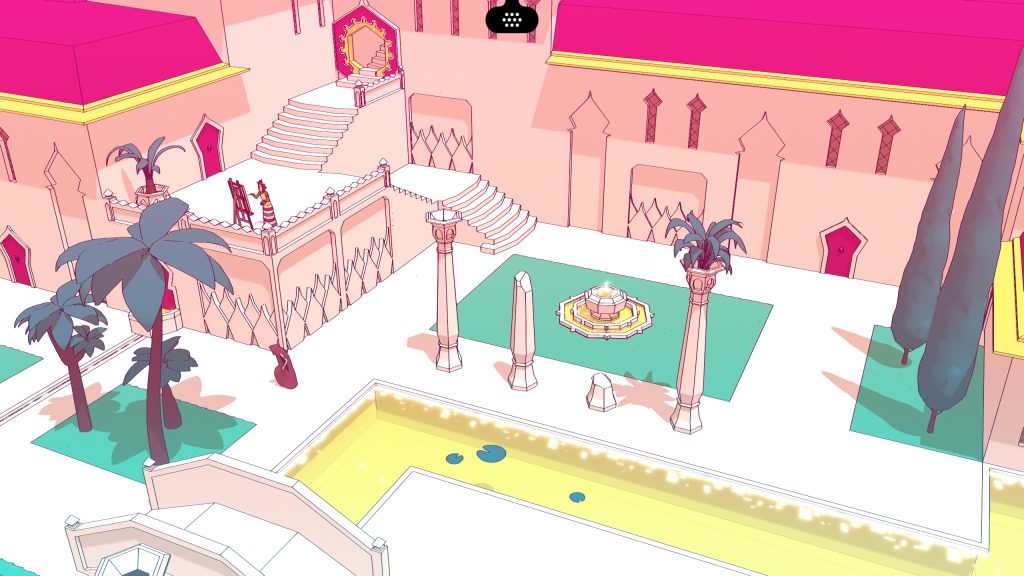
Chants of Sennaar is a language-deciphering puzzle game from French indie studio Rundisc. It takes place on the many levels of an enormous tower, where the silent protagonist must meet different cultures, work out their languages, and solve puzzles using that understanding. Its concept is inspired by the Tower of Babel story, in which the whole human race initially speaks a single language and uses their cooperative abilities to build a tower towards the heavens. As punishment for this hubris, God changes the builders' language into many different ones, causing them to lose the ability to communicate and cooperate. Eventually, these differing languages and cultures spread across the world.
Chants of Sennaar seems to take place in the immediate aftermath of this language-scrambling event, with various cultures living in segregated enclaves within the tower. Ascending the tower means speaking to the people at each level and interpreting their language well enough to find the path forward. Throughout the adventure, the player finds computer terminals that serve as save points, fast travel stations, and communication links between the various floors. What awaits the player at the top?

Mild Language
As the player explores the world, they'll find glyphs in the languages relevant to the area, often via signs, murals, or dialogue (written and verbal speech are collapsed together via speech bubbles). Each time a new glyph is encountered, the player can input their guesses to see them populated as tooltips when hovering over symbols and phrases in the world.
The central puzzle-solving tool of Chants of Sennaar is a logbook that holds the resolved meanings of each of the symbols encountered, a pictographic glossary of deciphered glyphs. When enough information has been gathered, a new page becomes available and must be filled in by the player. The whole page's slots must be filled with the correct glyphs in order to lock them in (the same several-correct-answers-at-a-time deduction resolution popularized by Return of the Obra Dinn). The logbook may also record certain images or scenes for easier reference as you explore the world.
Once the solutions for words are found, the answers are "locked in" in the logbook; any translation guesswork provided by the player is replaced with the canonical solution (in English, or whatever localized language is selected in the options). This creates some certitude with which to solve subsequent puzzles, but it also tends to flatten the feeling of solving the language. When the whole language glossary is solved, it no longer bears the player's own interpretations of the concepts and symbols. Instead, it allows the game designers to include certain grammatical conveniences when showing complete phrases (for example, "me me ascend stairs" might be adjusted to "we'll go upstairs" once all the words are known).
The languages themselves have some minor nuances to differentiate them, different grammatical structures and uses of punctuation or modifiers. These distinctions are fairly overt and not too hard to figure out, and they only gesture at the breadth of linguistic variety in the real world. Fortunately, the separation into various disparate languages (which keeps each area largely self-contained) does allow those few differences to be highlighted in a way that a single constructed language might not.

Universal Translator
The primary mechanism of solving puzzles and making your way through the world is by resolving glyphs into their translations. But there are other bits and pieces of point'n'click adventure games that move things along. Key items can be acquired and applied at the relevant place, certain objects can be picked up or interacted with, and a few key pieces of information can be earned via small diegetic minigames that help explain certain concepts.
There are some stealth sequences that seem to be disliked by most players, but I found them to be perfectly tolerable. The stealth interactions serve primarily narrative and pacing purposes. When one level of the tower involves sneaking between marching ranks until you can disguise yourself as one of them, it helps convey a clear distinction from a subsequent level in which the characters merely lounge around in a garden, indifferent to the player's presence. The stealth sections are brief and the checkpoints forgiving; at no point did a stealth sequence impede my progress for more than a minute or two, even when I needed multiple attempts to succeed.
The majority of the game takes place exploring one level at a time and focusing on the primary language that's present there. The final sequence, however, involves traversing back and revisiting areas, connecting speakers from different levels. This section fails to provide any especially interesting "final boss" linguistic puzzles, but it's an interesting little closing chapter with some fun twists that I don't want to spoil too much. It all wraps up with a nice little bow, and even the minor mechanics like the stealth and the minigames fit into it comfortably enough.

Conclusion
Ultimately, Chants of Sennaar's use of languages feels like one of its weaker elements; the rest is a very well-crafted adventure game, with cute little variations on gameplay but nothing so demanding as to be a roadblock. The language-deciphering elements are enough to sustain the duration of the game, but they want for additional complexity and nuance. The small grammatical details introduced (like doubling of symbols, placement of modifiers, etc.) are a great start, and feel like they need to be expanded upon.
But the place that the game lands is highly approachable and fun. Its tidy adventure-game packaging makes it an excellent introduction to the world of conlang (constructed language) deciphering, a jumping off point for casual players to gauge their interest. Having spoken to friends and coworkers who delve much deeper into this niche, Chants of Sennaar might be a good indicator of interest in more challenging implementations of some of its ideas. That's what makes it great: it's an appealing introduction to new kinds of challenges. I would love to see it get a more ambitious sequel that digs deeper into the nuances of languages.